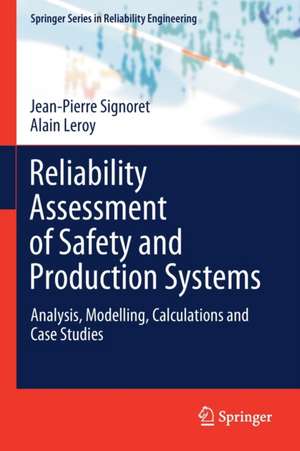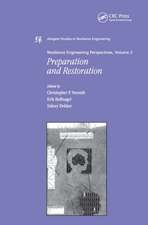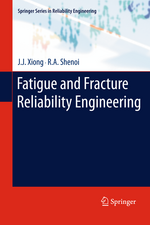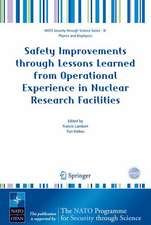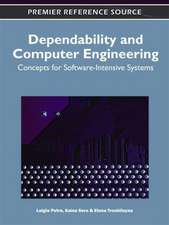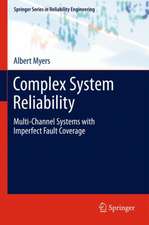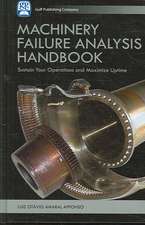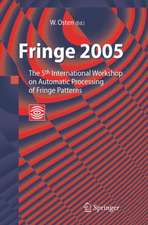Reliability Assessment of Safety and Production Systems: Analysis, Modelling, Calculations and Case Studies: Springer Series in Reliability Engineering
Autor Jean-Pierre Signoret, Alain Leroyen Limba Engleză Paperback – 24 mar 2022
Drawing on the authors’ extensive experience within the field of reliability engineering, it addresses and discusses a variety of topics, including:
• Background and overview of safety and dependability studies;
• Explanation and critical analysis of definitions related to core concepts;
• Risk identification through qualitative approaches (preliminary hazard analysis, HAZOP, FMECA, etc.);
• Modelling of industrial systems through static (fault tree, reliability block diagram), sequential (cause-consequence diagrams, event trees, LOPA, bowtie), and dynamic (Markov graphs, Petri nets) approaches;
• Probabilistic calculations through state-of-the-art analytical or Monte Carlo simulation techniques;
• Analysis, modelling, and calculations of common cause failure and uncertainties;
• Linkages and combinations between the various modelling and calculation approaches;
• Reliability data collection and standardization.
The book features illustrations, explanations, examples, and exercises to help readers gain a detailed understanding of the topic and implement it into their own work. Further, it analyses the production availability of production systems and the functional safety of safety systems (SIL calculations), showcasing specific applications of the general theory discussed. Given its scope, this book is a valuable resource for engineers, software designers, standard developers, professors, and students.
| Toate formatele și edițiile | Preț | Express |
|---|---|---|
| Paperback (1) | 810.19 lei 6-8 săpt. | |
| Springer International Publishing – 24 mar 2022 | 810.19 lei 6-8 săpt. | |
| Hardback (1) | 1143.52 lei 6-8 săpt. | |
| Springer International Publishing – 24 mar 2021 | 1143.52 lei 6-8 săpt. |
Din seria Springer Series in Reliability Engineering
- 18%
 Preț: 1406.66 lei
Preț: 1406.66 lei - 18%
 Preț: 1122.56 lei
Preț: 1122.56 lei - 20%
 Preț: 1277.89 lei
Preț: 1277.89 lei - 18%
 Preț: 952.09 lei
Preț: 952.09 lei - 24%
 Preț: 1048.70 lei
Preț: 1048.70 lei - 20%
 Preț: 940.34 lei
Preț: 940.34 lei - 20%
 Preț: 987.32 lei
Preț: 987.32 lei - 18%
 Preț: 951.29 lei
Preț: 951.29 lei - 18%
 Preț: 947.02 lei
Preț: 947.02 lei - 15%
 Preț: 651.51 lei
Preț: 651.51 lei - 15%
 Preț: 635.65 lei
Preț: 635.65 lei - 18%
 Preț: 1228.44 lei
Preț: 1228.44 lei - 18%
 Preț: 1227.67 lei
Preț: 1227.67 lei - 18%
 Preț: 952.89 lei
Preț: 952.89 lei - 18%
 Preț: 1234.94 lei
Preț: 1234.94 lei - 18%
 Preț: 952.09 lei
Preț: 952.09 lei - 18%
 Preț: 1236.19 lei
Preț: 1236.19 lei - 18%
 Preț: 1322.35 lei
Preț: 1322.35 lei - 20%
 Preț: 1274.57 lei
Preț: 1274.57 lei - 15%
 Preț: 643.34 lei
Preț: 643.34 lei - 18%
 Preț: 1109.16 lei
Preț: 1109.16 lei - 15%
 Preț: 635.65 lei
Preț: 635.65 lei - 15%
 Preț: 654.62 lei
Preț: 654.62 lei - 18%
 Preț: 944.99 lei
Preț: 944.99 lei - 18%
 Preț: 953.65 lei
Preț: 953.65 lei - 18%
 Preț: 1213.16 lei
Preț: 1213.16 lei - 18%
 Preț: 956.50 lei
Preț: 956.50 lei - 15%
 Preț: 644.95 lei
Preț: 644.95 lei - 18%
 Preț: 950.52 lei
Preț: 950.52 lei - 18%
 Preț: 1233.97 lei
Preț: 1233.97 lei - 15%
 Preț: 640.06 lei
Preț: 640.06 lei - 18%
 Preț: 956.69 lei
Preț: 956.69 lei - 18%
 Preț: 940.39 lei
Preț: 940.39 lei - 18%
 Preț: 948.92 lei
Preț: 948.92 lei -
 Preț: 389.70 lei
Preț: 389.70 lei - 18%
 Preț: 943.73 lei
Preț: 943.73 lei - 18%
 Preț: 940.57 lei
Preț: 940.57 lei - 20%
 Preț: 985.03 lei
Preț: 985.03 lei - 18%
 Preț: 943.43 lei
Preț: 943.43 lei - 18%
 Preț: 1218.21 lei
Preț: 1218.21 lei - 18%
 Preț: 948.16 lei
Preț: 948.16 lei - 18%
 Preț: 948.92 lei
Preț: 948.92 lei - 18%
 Preț: 1727.24 lei
Preț: 1727.24 lei - 15%
 Preț: 638.43 lei
Preț: 638.43 lei - 24%
 Preț: 802.76 lei
Preț: 802.76 lei
Preț: 810.19 lei
Preț vechi: 988.04 lei
-18% Nou
Puncte Express: 1215
Preț estimativ în valută:
155.07€ • 167.38$ • 130.02£
155.07€ • 167.38$ • 130.02£
Carte tipărită la comandă
Livrare economică 19 aprilie-03 mai
Preluare comenzi: 021 569.72.76
Specificații
ISBN-13: 9783030647100
ISBN-10: 3030647102
Ilustrații: XXXIV, 878 p. 595 illus.
Dimensiuni: 155 x 235 mm
Greutate: 1.25 kg
Ediția:1st ed. 2021
Editura: Springer International Publishing
Colecția Springer
Seria Springer Series in Reliability Engineering
Locul publicării:Cham, Switzerland
ISBN-10: 3030647102
Ilustrații: XXXIV, 878 p. 595 illus.
Dimensiuni: 155 x 235 mm
Greutate: 1.25 kg
Ediția:1st ed. 2021
Editura: Springer International Publishing
Colecția Springer
Seria Springer Series in Reliability Engineering
Locul publicării:Cham, Switzerland
Cuprins
Overview of the Book.- Introduction.- Background.- Reliability Study Overview.- Basic Core Concepts.- Introduction to Production Availability Calculations.- Introduction to SIL Calculations.- Risk Identification and Qualitative Analyses.- Inductive Methods.- Preliminary Hazard Analyses.- HAZOP.- FMECA.- Additional Methods.- Comparison of Inductive Approaches.- Modelling of Static Systems.- Boolean Methods.- Introduction to the Boolean Methods.- Main Assumptions and Mathematical Bases.- Reliability Block Diagrams.- Fault Tree Analysis.- Qualitative Analyses.- Extension to Non-coherent RBDs and FTs.- Basic Probability Calculations.- Semi-Quantitative Analysis.- Basic Probability Calculations for Large Systems.- Time Dependent Calculations.- Common Cause Failure Analysis.- Importance Factors.- Uncertainty Propagation.- Sequential Analysis.- Combination with Other Methods.- Belief Networks.- Limits and Conclusions.- Stochastic Processes and Dynamic Systems.- Introduction.- Markovian Modelling.- Monte-Carlo Calculations.- Petri Net Modelling.- Conclusions.- Production Availability and SIL Calculations.- Extension to Production Availability Calculations.- Extension to SIL Calculations.- Conclusion.
Notă biografică
Alain Leroy started his career in offshore engineering and was for ten years with the insurance industry. However, he has worked for most of his career in reliability engineering, focusing mainly on the implementation and use of novel approaches and techniques for assessing dependability parameters in the oil and gas industry. He has delivered courses on reliability at both basic and high levels.
Jean-Pierre Signoret has been in charge of the research and development of methods and tools in reliability engineering, as well as of practical studies related to reliability modelling. He is still involved in the development of several international standards, including IEC and ISO, related to dependability, functional safety, reliability data collection, and production assurance. As a member of TPA, he gives short courses in various universities on this topic.
Jean-Pierre Signoret has been in charge of the research and development of methods and tools in reliability engineering, as well as of practical studies related to reliability modelling. He is still involved in the development of several international standards, including IEC and ISO, related to dependability, functional safety, reliability data collection, and production assurance. As a member of TPA, he gives short courses in various universities on this topic.
Textul de pe ultima copertă
This book provides, as simply as possible, sound foundations for an in-depth understanding of reliability engineering with regard to qualitative analysis, modelling, and probabilistic calculations of safety and production systems.
Drawing on the authors’ extensive experience within the field of reliability engineering, it addresses and discusses a variety of topics, including:
• Background and overview of safety and dependability studies;
• Explanation and critical analysis of definitions related to core concepts;
• Risk identification through qualitative approaches (preliminary hazard analysis, HAZOP, FMECA, etc.);
• Modelling of industrial systems through static (fault tree, reliability block diagram), sequential (cause-consequence diagrams, event trees, LOPA, bowtie), and dynamic (Markov graphs, Petri nets) approaches;
• Probabilistic calculations through state-of-the-art analytical or Monte Carlo simulation techniques;
• Analysis, modelling, and calculations of common cause failure and uncertainties;
• Linkages and combinations between the various modelling and calculation approaches;
• Reliability data collection and standardization.
The book features illustrations, explanations, examples, and exercises to help readers gain a detailed understanding of the topic and implement it into their own work. Further, it analyses the production availability of production systems and the functional safety of safety systems (SIL calculations), showcasing specific applications of the general theory discussed. Given its scope, this book is a valuable resource for engineers, software designers, standard developers, professors, and students.
Drawing on the authors’ extensive experience within the field of reliability engineering, it addresses and discusses a variety of topics, including:
• Background and overview of safety and dependability studies;
• Explanation and critical analysis of definitions related to core concepts;
• Risk identification through qualitative approaches (preliminary hazard analysis, HAZOP, FMECA, etc.);
• Modelling of industrial systems through static (fault tree, reliability block diagram), sequential (cause-consequence diagrams, event trees, LOPA, bowtie), and dynamic (Markov graphs, Petri nets) approaches;
• Probabilistic calculations through state-of-the-art analytical or Monte Carlo simulation techniques;
• Analysis, modelling, and calculations of common cause failure and uncertainties;
• Linkages and combinations between the various modelling and calculation approaches;
• Reliability data collection and standardization.
The book features illustrations, explanations, examples, and exercises to help readers gain a detailed understanding of the topic and implement it into their own work. Further, it analyses the production availability of production systems and the functional safety of safety systems (SIL calculations), showcasing specific applications of the general theory discussed. Given its scope, this book is a valuable resource for engineers, software designers, standard developers, professors, and students.
Caracteristici
Provides the foundations for an in-depth understanding of reliability engineering Includes illustrations, exercises, and case studies to aid learning Presents real-world applications of the general theory discussed
